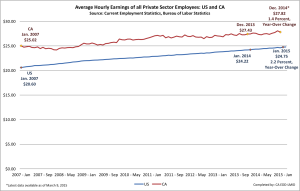In public policy, we often ignore the obvious, due to partisanship, the desire to get along, or ideology. So it is with last Friday’s “puzzle” over both the state and federal jobs reports showing strong job gains, with weak wage growth.
 This past Friday, due to the annual benchmarking process by EDD, both the state jobs report for January and the federal job report for February were issued on the same day. Despite the differences in time and geography, the meme for the two was similar: job gains were strong, but were being accompanied by weak wage growth. Many jobs are being created and/or sustained, but they are not good paying jobs.
This past Friday, due to the annual benchmarking process by EDD, both the state jobs report for January and the federal job report for February were issued on the same day. Despite the differences in time and geography, the meme for the two was similar: job gains were strong, but were being accompanied by weak wage growth. Many jobs are being created and/or sustained, but they are not good paying jobs.
On the national level, 295,000 net new jobs were added in February, but average hourly earnings increased by only .01%. Jim Puzzanghera of the Los Angeles Times entitled his summary of the federal jobs report, “Disappointing wage growth adds sobering note to strong jobs report”. Gus Faucher, a senior economist at PNC Financial Services, tells Puzzanghera that “that’s the missing piece of the labor market puzzle, better wage growth”.
On the state level, the report for January found a very impressive 67,300 jobs created. Though wage gain information was not available last Friday for the state level, other recent studies in California have noted the strongest job growth in California in generally lower-paying sectors, such as hospitality.
The chart above (click to enlarge) was prepared by EDD’s Labor Market Information Division. Research program specialist Brandon Hooker tracked average hourly earnings for the United States and California since 2007. In the period between January 2014 and January 2015, the nation’s wage gains totaled only 2.2%. On the state level, the period between December 2013 and December 2014 saw wage gains of 1.4%.
Strong job growth and low wage gains: Is there a puzzle as economist Faucher suggests? Various explanations have been put forward in the past month, ranging from the usual ones of technology, globalization, and the weakness of private sector unions to more exotic ones involving “pent up wage cuts”.
Each of these factors should be more fully discussed in our California policy discussions of 2015. So too should be an additional factor: the continued importation of workers, directly and indirectly, not only in tech and agriculture, but in a wide variety of occupations and sectors. What are the impacts of this importation of workers on wages, along with the impacts (positive and negative), on jobs for others, and on a middle class society in California? Should we care about a middle class society? How much are we benefiting from cheaper goods and services, and how much are we ignoring the costs, including costs of public services? These are discussions for some time overdue.

